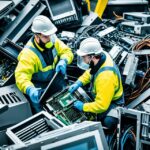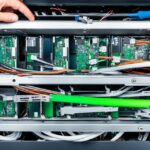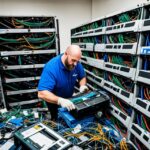Server Recycling: A Guide for IT Procurement Managers
Welcome to our comprehensive guide on server recycling strategies for IT procurement managers. In today’s rapidly advancing technological landscape, the responsible disposal of old office equipment has become a pressing concern. It is crucial for businesses to implement effective recycling practices to contribute to the green revolution and ensure environmental sustainability. In this guide, we will explore the importance of IT asset management, compliance with WEEE (Waste Electric and Electronic Equipment) recycling regulations, and the benefits of proper server recycling.
As an IT procurement manager, you play a vital role in shaping the future of technology by making informed decisions on the disposal of outdated hardware. By adopting innovative IT procurement recycling strategies, you can not only contribute to a greener digital future but also optimize your organization’s operations and reduce environmental impact. It’s time to embrace the green revolution and unlock the potential of sustainable server recycling.
In the following sections, we will navigate through the intricacies of WEEE recycling, discuss requirements and compliance, explore the environmental benefits, and highlight the financial incentives of recycling used IT equipment. Together, let’s embark on a journey towards a more sustainable future. Get ready to transform your IT procurement practices into powerful drivers of change. Let’s make a difference, one server at a time.
What is WEEE Recycling?
WEEE recycling stands for waste electric and electronic equipment recycling. It encompasses the disposal of any electronic equipment that requires a battery or mains power, such as household appliances, medical equipment, and computer equipment. IT procurement managers must ensure that all data on these devices is irretrievably wiped or destroyed before recycling them to comply with data protection requirements. Forensic data wiping techniques are used to permanently erase drive contents, eliminating the possibility of data breaches. Compliance with industry codes and obtaining detailed certificates of destruction are essential for businesses engaging in WEEE recycling.
| Benefits of WEEE Recycling | Best Practices |
|---|---|
|
|
Requirements for WEEE Recycling
Proper WEEE recycling is crucial for businesses to comply with data protection requirements and ensure secure data destruction and data sanitization processes. Non-compliance with data protection laws, such as the General Data Protection Regulation (GDPR), can result in hefty fines and significant reputational damage.
The National Cyber Security Centre (NCSC) provides valuable guidance on effective data sanitization techniques, including destructive measures and forensic data wiping. These methods ensure that all data on electronic devices is irretrievably erased, eliminating the risk of data breaches and protecting sensitive information.
In addition to data protection requirements, businesses involved in WEEE recycling must adhere to industry codes and regulations set forth by authoritative bodies. For example, the British government’s Communications-Electronics Security Group (CESG) and Centre for the Protection of National Infrastructure (CPNI) outline specific guidelines to ensure the secure disposal of electronic equipment.
To ensure compliance and accountability, businesses should provide detailed documentation and certificates of destruction, demonstrating their commitment to responsible WEEE recycling practices.
Guidelines for Secure Data Destruction:
- Utilize forensic data wiping techniques, such as overwriting drive contents multiple times with random patterns, to render data unrecoverable.
- Physically destroy storage media, including hard drives, solid-state drives, and other data-bearing components.
- Implement data sanitization procedures that comply with industry standards and regulations.
- Ensure all data sanitization processes are well-documented and can be audited for compliance purposes.
Industry Codes and Regulations:
| Authority | Code/Regulation |
|---|---|
| Communications-Electronics Security Group (CESG) | Secure Sanitization of Protectively Marked Sensitive Information |
| Centre for the Protection of National Infrastructure (CPNI) | Data Destruction and Information Assurance Policy |
Adhering to these industry codes and regulations ensures that businesses meet the required standards for secure WEEE recycling, maintain data protection compliance, and mitigate potential risks associated with improper disposal of electronic equipment.
Environmental Protection through WEEE Recycling
One of the main purposes of WEEE recycling is to prevent environmental damage caused by the improper disposal of electronic equipment. Harmful materials like lead, mercury, and plastics can have detrimental effects on ecosystems if they end up in landfills. WEEE recycling ensures that these materials are safely disposed of and that valuable resources like gold, silver, and copper are recovered for reuse.
By minimizing unnecessary energy usage and showcasing their green credentials, businesses can enhance their environmental reputation and attract environmentally-conscious customers. This not only contributes to the preservation of natural resources but also promotes a sustainable future. Corporate obligations to protect the environment extend beyond legal requirements, and responsible WEEE recycling plays a crucial role in fulfilling these obligations.
Failure to comply with environmental regulations can result in reputational damage and financial losses. Proper handling of electronic waste demonstrates a commitment to sustainable practices and can help businesses mitigate the risk of negative publicity and customer backlash.
Furthermore, WEEE recycling enables the recovery of valuable resources from discarded electronic equipment. This reduces the need for raw materials extraction and minimizes energy-intensive mining processes. By optimizing the reuse and recycling of electronic components, businesses can contribute to a circular economy and minimize their carbon footprint.
Overall, environmental protection through WEEE recycling not only safeguards ecosystems from harmful materials but also helps businesses meet their corporate social responsibility and sustainability goals. By actively managing and minimizing their electronic waste, organizations can create a positive impact on the environment and establish themselves as leaders in sustainable practices.
Get Paid to Recycle Used IT Equipment
Recycling used IT equipment can offer significant financial benefits for businesses. In addition to contributing to a greener environment, organizations can also receive upfront payment or rebates from IT asset management companies for their used equipment. Whether the equipment is recycled, destroyed, or refurbished, businesses can unlock value from their old IT assets.
Data destruction is a crucial step in the IT equipment recycling process. Before allowing data-bearing devices to leave company premises, it is essential to ensure that all sensitive information is securely wiped or destroyed to prevent data breaches. By incorporating data sanitization services into their procurement decisions, organizations can safeguard their data and comply with data protection regulations.
“Secure data destruction is the cornerstone of responsible IT equipment recycling.”
In addition to protecting data, businesses can also receive financial incentives for refreshing their IT suite. By choosing IT asset management companies that offer data sanitization services and recycling programs, organizations can not only ensure the secure disposal of data but also receive monetary benefits such as rebates or credit towards new equipment.
Furthermore, reusing older devices through wiping and installing new operating systems can be a cost-effective solution. Instead of investing in entirely new equipment, businesses can extend the life of their IT assets, reducing costs and minimizing waste.
“Reusing older devices can help businesses save money while contributing to a sustainable IT ecosystem.”
To illustrate the cost-effectiveness of IT equipment recycling, consider the following table:
| Scenario | Cost |
|---|---|
| Recycling and Refreshing | £0 (rebate received) |
| Purchasing New Equipment | £10,000 |
In the above scenario, recycling and refreshing the IT equipment not only saves the business £10,000 in upfront costs but also helps maintain a sustainable approach to technology consumption.
How to Source WEEE Recycling Services
When it comes to sourcing WEEE recycling services, IT procurement managers must follow proper procurement procedures and ensure strategic alignment with the organization’s goals. It is crucial to consider factors such as lifecycle cost and the expected lifespan of devices to evaluate the total cost of ownership. By exploring alternatives to purchasing new equipment, such as remanufactured or refurbished devices, organizations can not only save costs but also contribute to sustainability efforts.
Leasing options can also be considered to improve cash flow and provide flexibility in managing IT assets. Developing a replacement timetable and staying on top of upgrades can help ensure the smooth management of the IT infrastructure and prevent unnecessary replacements.
Moreover, maintaining a database of equipment and monitoring utilization can provide valuable insights to optimize resource allocation. This proactive approach can help organizations make informed decisions about when to refresh or retire devices, maximizing their value and minimizing environmental impact.
“Sourcing WEEE recycling services requires a holistic approach that integrates procurement procedures, strategic alignment, and lifecycle cost evaluation.”
| Procurement Strategies | Benefits |
|---|---|
| Consider remanufactured or refurbished devices | – Cost-effective alternative to new equipment – Reduces environmental impact – Supports circular economy |
| Explore leasing options | – Improves cash flow – Provides flexibility in equipment management – Easy access to latest technology |
| Develop a replacement timetable | – Ensures timely upgrades – Optimal utilization of devices – Prevents unnecessary replacements |
| Monitor equipment utilization | – Data-driven decision-making – Identifies underutilized devices – Optimizes resource allocation |
By adopting these strategies and incorporating them into the procurement process, organizations can not only meet their recycling obligations but also contribute to environmental sustainability. Furthermore, sourcing WEEE recycling services responsibly can result in cost savings, improved cash flow, and enhanced corporate reputation.
Conclusion
IT procurement managers play a crucial role in implementing server recycling strategies that promote environmental sustainability. By following the best practices outlined in this guide, businesses can optimize their IT operations, reduce their environmental impact, and demonstrate their commitment to sustainable practices.
Proper WEEE recycling, including secure data destruction and compliance with industry codes, is essential for protecting businesses from legal and reputational risks. By responsibly disposing of outdated equipment and ensuring the secure destruction of data, IT procurement managers safeguard valuable information and maintain compliance with data protection requirements.
Furthermore, considering alternatives to purchasing new equipment, optimizing resource usage, and staying on top of refresh cycles can contribute to cost-effectiveness and long-term sustainability. By embracing server recycling, IT procurement managers can lead the green revolution and contribute to a greener digital future.
FAQ
What is the purpose of WEEE recycling?
WEEE recycling aims to prevent environmental damage caused by improper disposal of electronic equipment, ensure the secure disposal of data, and recover valuable resources for reuse.
Why is proper WEEE recycling important for businesses?
Proper WEEE recycling helps businesses avoid legal and reputational damage, comply with data protection requirements, and enhance their environmental reputation.
What are the data protection requirements for WEEE recycling?
Data protection requirements for WEEE recycling include secure data destruction and data sanitization processes that comply with industry codes and regulations.
What are the potential consequences of non-compliance with data protection laws?
Non-compliance with data protection laws such as GDPR can result in significant fines and reputational damage for businesses.
How can businesses benefit financially from recycling used IT equipment?
Businesses can receive upfront payment or rebates for used IT equipment that can be recycled, destroyed, or refurbished.
What factors should IT procurement managers consider when sourcing WEEE recycling services?
IT procurement managers should consider factors such as total cost of ownership, lifecycle cost, expected lifespan of devices, and explore alternatives to purchasing new equipment.
How can IT procurement managers contribute to environmental sustainability through server recycling?
IT procurement managers can contribute to environmental sustainability by implementing server recycling strategies, optimizing resource usage, and staying on top of refresh cycles.















